Corporate Finance: Analysis of Proposed Project and Weighted Average Cost of Capital
VerifiedAdded on 2023/06/09
|9
|1874
|116
AI Summary
This article provides an analysis of the proposed project of Bega Cheese Ltd. for diversifying the business by introducing new yoghurt products. It includes the computation of Weighted Average Cost of Capital, NPV and IRR analysis under normal, best and worst case scenarios. The article also provides investment decisions based on the analysis.
Contribute Materials
Your contribution can guide someone’s learning journey. Share your
documents today.
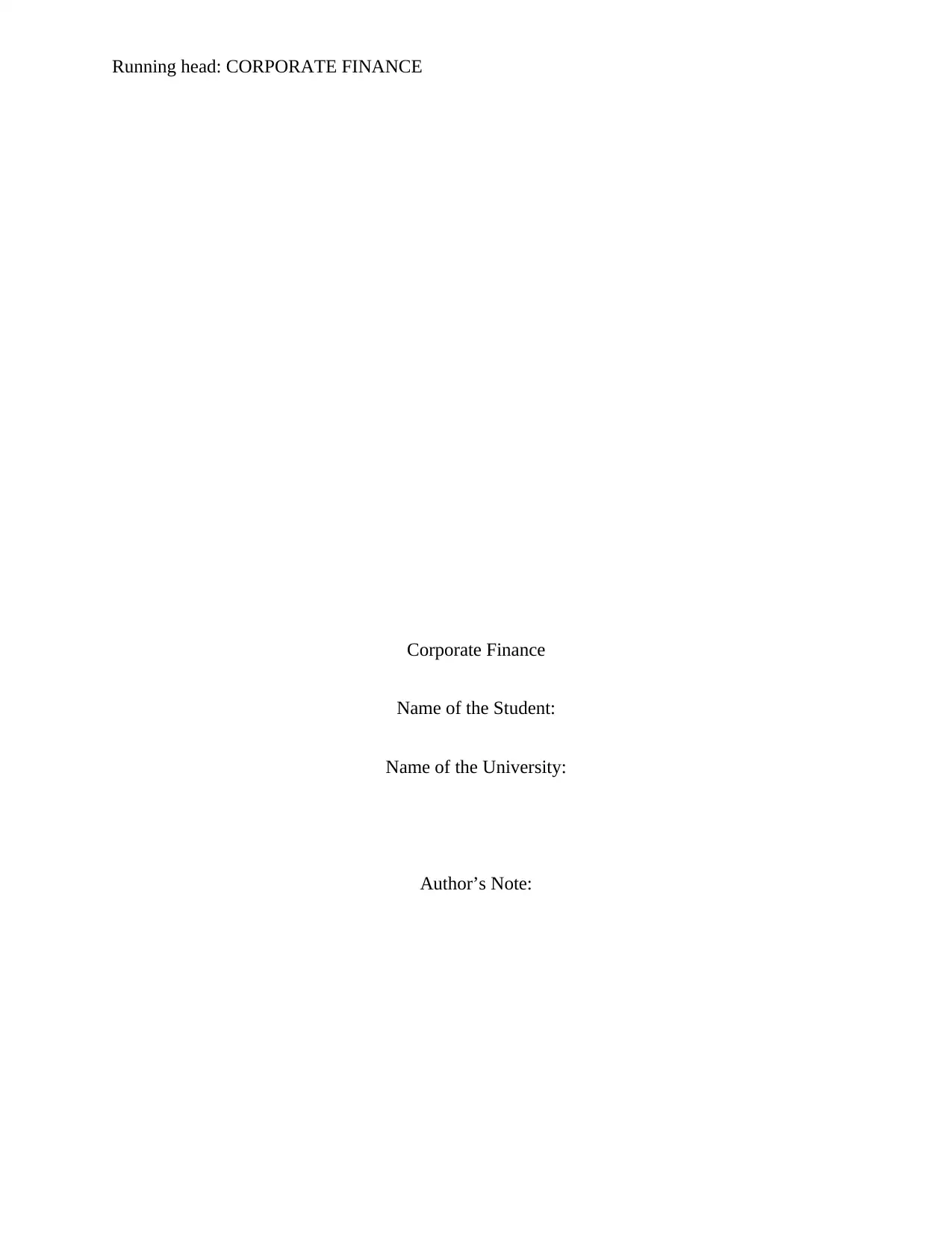
Running head: CORPORATE FINANCE
Corporate Finance
Name of the Student:
Name of the University:
Author’s Note:
Corporate Finance
Name of the Student:
Name of the University:
Author’s Note:
Secure Best Marks with AI Grader
Need help grading? Try our AI Grader for instant feedback on your assignments.
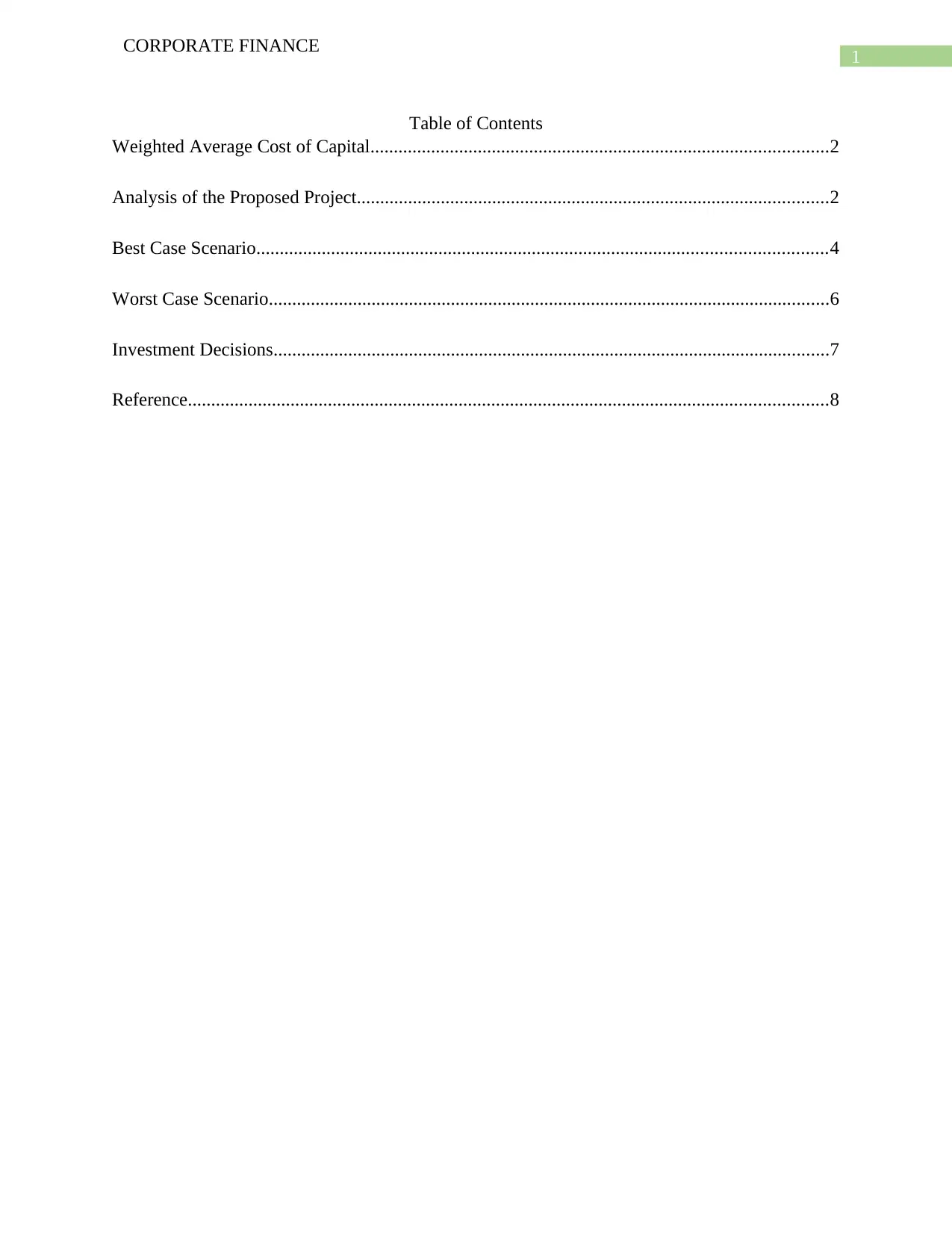
1
CORPORATE FINANCE
Table of Contents
Weighted Average Cost of Capital..................................................................................................2
Analysis of the Proposed Project.....................................................................................................2
Best Case Scenario..........................................................................................................................4
Worst Case Scenario........................................................................................................................6
Investment Decisions.......................................................................................................................7
Reference.........................................................................................................................................8
CORPORATE FINANCE
Table of Contents
Weighted Average Cost of Capital..................................................................................................2
Analysis of the Proposed Project.....................................................................................................2
Best Case Scenario..........................................................................................................................4
Worst Case Scenario........................................................................................................................6
Investment Decisions.......................................................................................................................7
Reference.........................................................................................................................................8
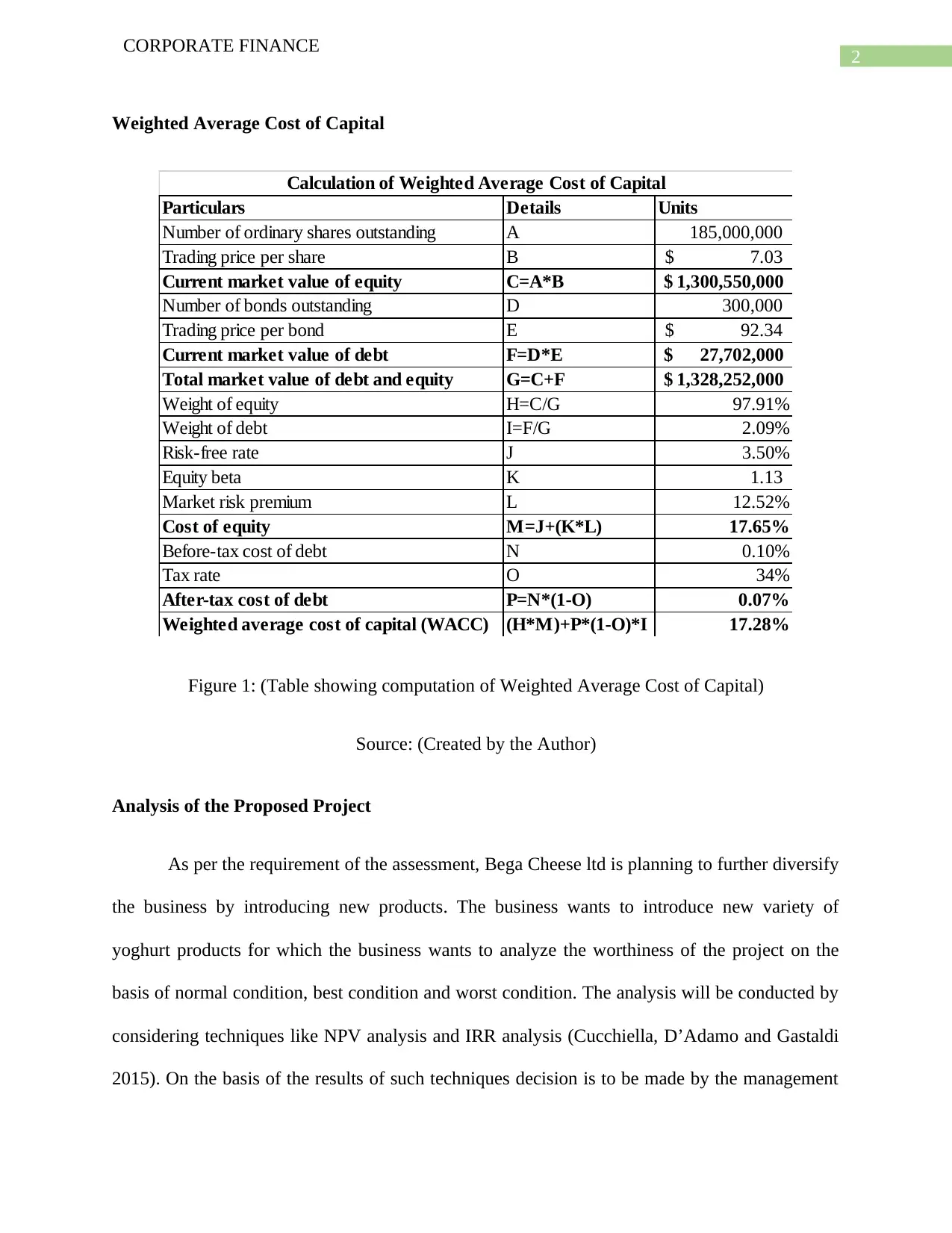
2
CORPORATE FINANCE
Weighted Average Cost of Capital
Particulars Details Units
Number of ordinary shares outstanding A 185,000,000
Trading price per share B 7.03$
Current market value of equity C=A*B 1,300,550,000$
Number of bonds outstanding D 300,000
Trading price per bond E 92.34$
Current market value of debt F=D*E 27,702,000$
Total market value of debt and equity G=C+F 1,328,252,000$
Weight of equity H=C/G 97.91%
Weight of debt I=F/G 2.09%
Risk-free rate J 3.50%
Equity beta K 1.13
Market risk premium L 12.52%
Cost of equity M=J+(K*L) 17.65%
Before-tax cost of debt N 0.10%
Tax rate O 34%
After-tax cost of debt P=N*(1-O) 0.07%
Weighted average cost of capital (WACC) (H*M)+P*(1-O)*I 17.28%
Calculation of Weighted Average Cost of Capital
Figure 1: (Table showing computation of Weighted Average Cost of Capital)
Source: (Created by the Author)
Analysis of the Proposed Project
As per the requirement of the assessment, Bega Cheese ltd is planning to further diversify
the business by introducing new products. The business wants to introduce new variety of
yoghurt products for which the business wants to analyze the worthiness of the project on the
basis of normal condition, best condition and worst condition. The analysis will be conducted by
considering techniques like NPV analysis and IRR analysis (Cucchiella, D’Adamo and Gastaldi
2015). On the basis of the results of such techniques decision is to be made by the management
CORPORATE FINANCE
Weighted Average Cost of Capital
Particulars Details Units
Number of ordinary shares outstanding A 185,000,000
Trading price per share B 7.03$
Current market value of equity C=A*B 1,300,550,000$
Number of bonds outstanding D 300,000
Trading price per bond E 92.34$
Current market value of debt F=D*E 27,702,000$
Total market value of debt and equity G=C+F 1,328,252,000$
Weight of equity H=C/G 97.91%
Weight of debt I=F/G 2.09%
Risk-free rate J 3.50%
Equity beta K 1.13
Market risk premium L 12.52%
Cost of equity M=J+(K*L) 17.65%
Before-tax cost of debt N 0.10%
Tax rate O 34%
After-tax cost of debt P=N*(1-O) 0.07%
Weighted average cost of capital (WACC) (H*M)+P*(1-O)*I 17.28%
Calculation of Weighted Average Cost of Capital
Figure 1: (Table showing computation of Weighted Average Cost of Capital)
Source: (Created by the Author)
Analysis of the Proposed Project
As per the requirement of the assessment, Bega Cheese ltd is planning to further diversify
the business by introducing new products. The business wants to introduce new variety of
yoghurt products for which the business wants to analyze the worthiness of the project on the
basis of normal condition, best condition and worst condition. The analysis will be conducted by
considering techniques like NPV analysis and IRR analysis (Cucchiella, D’Adamo and Gastaldi
2015). On the basis of the results of such techniques decision is to be made by the management
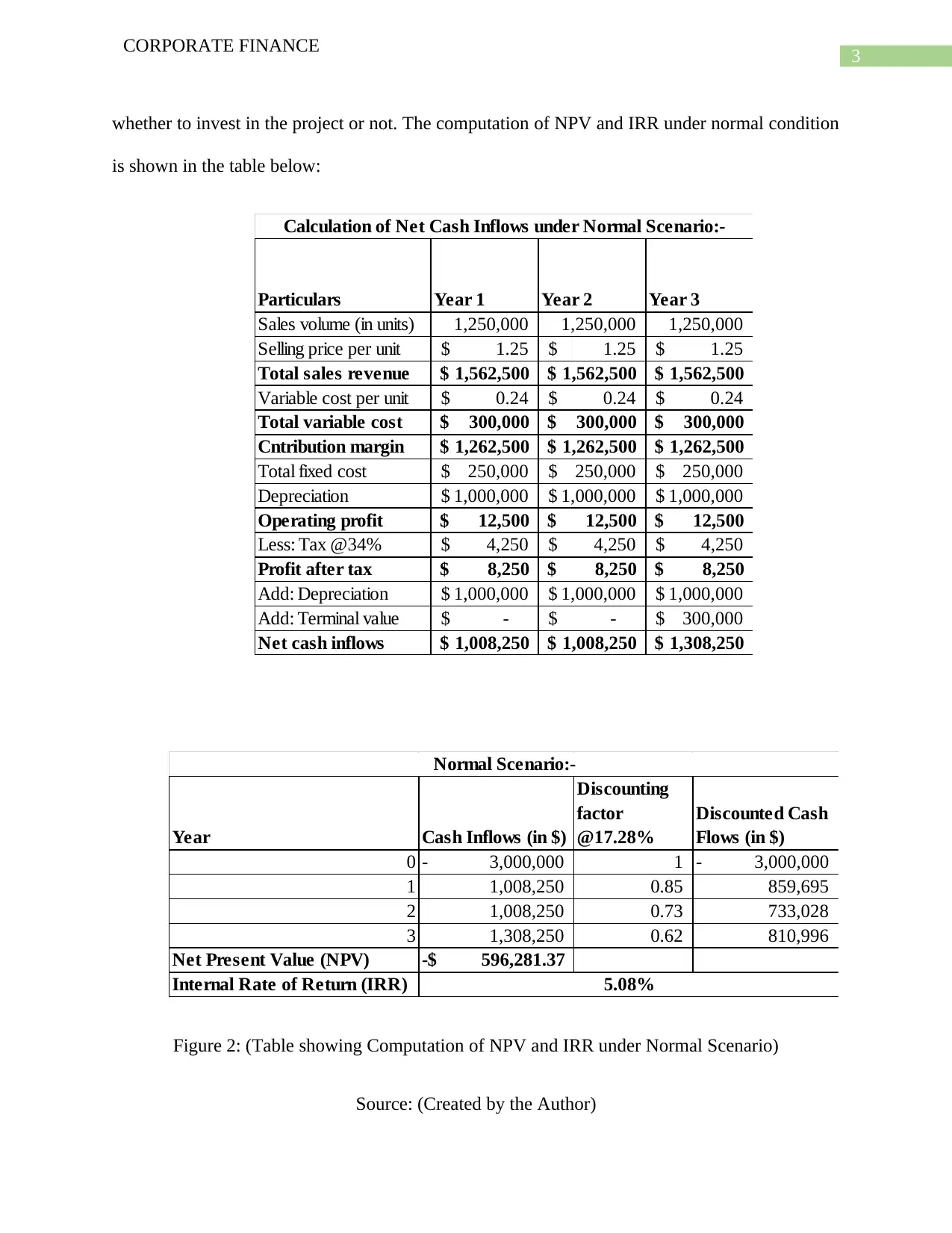
3
CORPORATE FINANCE
whether to invest in the project or not. The computation of NPV and IRR under normal condition
is shown in the table below:
Particulars Year 1 Year 2 Year 3
Sales volume (in units) 1,250,000 1,250,000 1,250,000
Selling price per unit 1.25$ 1.25$ 1.25$
Total sales revenue 1,562,500$ 1,562,500$ 1,562,500$
Variable cost per unit 0.24$ 0.24$ 0.24$
Total variable cost 300,000$ 300,000$ 300,000$
Cntribution margin 1,262,500$ 1,262,500$ 1,262,500$
Total fixed cost 250,000$ 250,000$ 250,000$
Depreciation 1,000,000$ 1,000,000$ 1,000,000$
Operating profit 12,500$ 12,500$ 12,500$
Less: Tax @34% 4,250$ 4,250$ 4,250$
Profit after tax 8,250$ 8,250$ 8,250$
Add: Depreciation 1,000,000$ 1,000,000$ 1,000,000$
Add: Terminal value -$ -$ 300,000$
Net cash inflows 1,008,250$ 1,008,250$ 1,308,250$
Calculation of Net Cash Inflows under Normal Scenario:-
Year Cash Inflows (in $)
Discounting
factor
@17.28%
Discounted Cash
Flows (in $)
0 3,000,000- 1 3,000,000-
1 1,008,250 0.85 859,695
2 1,008,250 0.73 733,028
3 1,308,250 0.62 810,996
Net Present Value (NPV) 596,281.37-$
Internal Rate of Return (IRR) 5.08%
Normal Scenario:-
Figure 2: (Table showing Computation of NPV and IRR under Normal Scenario)
Source: (Created by the Author)
CORPORATE FINANCE
whether to invest in the project or not. The computation of NPV and IRR under normal condition
is shown in the table below:
Particulars Year 1 Year 2 Year 3
Sales volume (in units) 1,250,000 1,250,000 1,250,000
Selling price per unit 1.25$ 1.25$ 1.25$
Total sales revenue 1,562,500$ 1,562,500$ 1,562,500$
Variable cost per unit 0.24$ 0.24$ 0.24$
Total variable cost 300,000$ 300,000$ 300,000$
Cntribution margin 1,262,500$ 1,262,500$ 1,262,500$
Total fixed cost 250,000$ 250,000$ 250,000$
Depreciation 1,000,000$ 1,000,000$ 1,000,000$
Operating profit 12,500$ 12,500$ 12,500$
Less: Tax @34% 4,250$ 4,250$ 4,250$
Profit after tax 8,250$ 8,250$ 8,250$
Add: Depreciation 1,000,000$ 1,000,000$ 1,000,000$
Add: Terminal value -$ -$ 300,000$
Net cash inflows 1,008,250$ 1,008,250$ 1,308,250$
Calculation of Net Cash Inflows under Normal Scenario:-
Year Cash Inflows (in $)
Discounting
factor
@17.28%
Discounted Cash
Flows (in $)
0 3,000,000- 1 3,000,000-
1 1,008,250 0.85 859,695
2 1,008,250 0.73 733,028
3 1,308,250 0.62 810,996
Net Present Value (NPV) 596,281.37-$
Internal Rate of Return (IRR) 5.08%
Normal Scenario:-
Figure 2: (Table showing Computation of NPV and IRR under Normal Scenario)
Source: (Created by the Author)
Secure Best Marks with AI Grader
Need help grading? Try our AI Grader for instant feedback on your assignments.
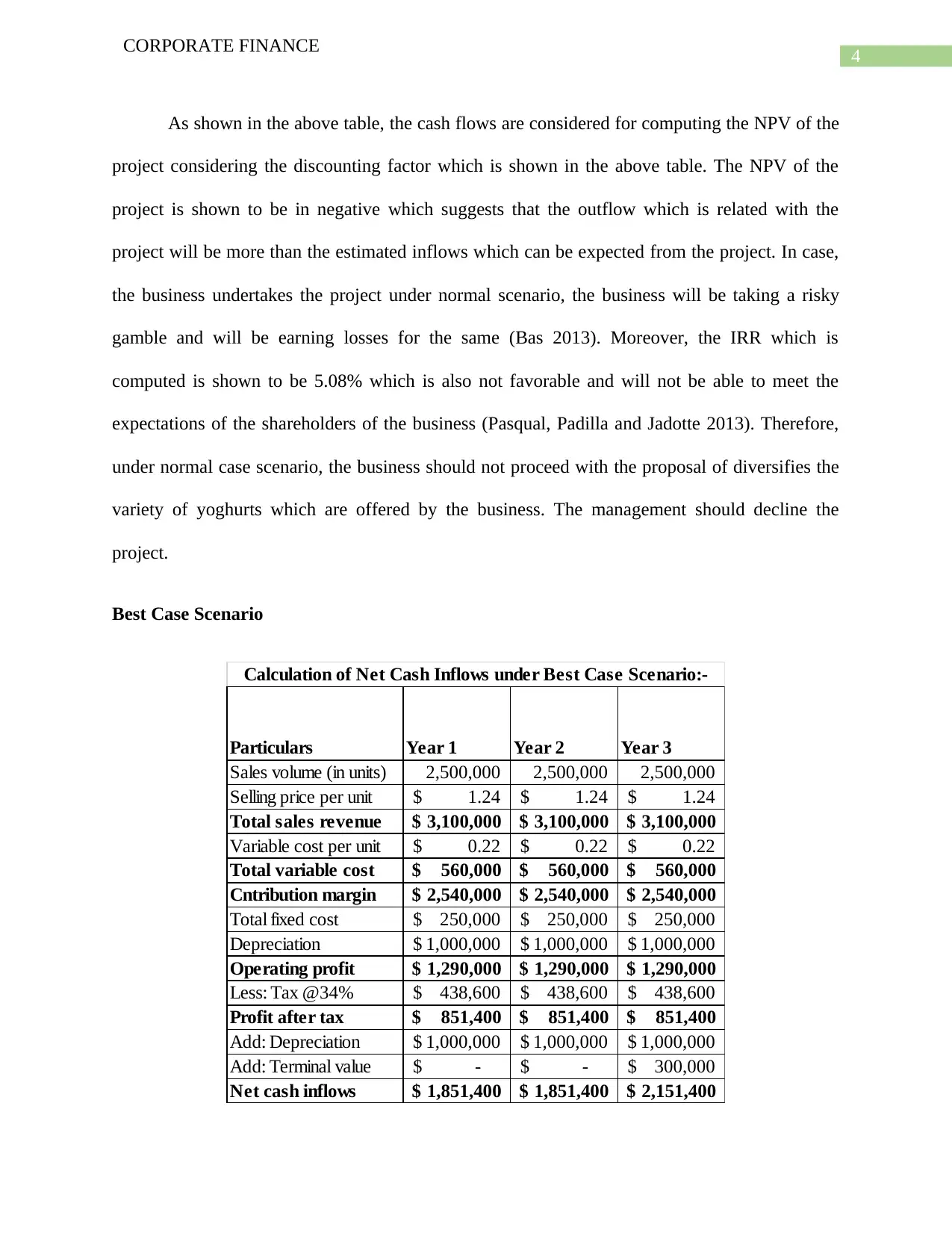
4
CORPORATE FINANCE
As shown in the above table, the cash flows are considered for computing the NPV of the
project considering the discounting factor which is shown in the above table. The NPV of the
project is shown to be in negative which suggests that the outflow which is related with the
project will be more than the estimated inflows which can be expected from the project. In case,
the business undertakes the project under normal scenario, the business will be taking a risky
gamble and will be earning losses for the same (Bas 2013). Moreover, the IRR which is
computed is shown to be 5.08% which is also not favorable and will not be able to meet the
expectations of the shareholders of the business (Pasqual, Padilla and Jadotte 2013). Therefore,
under normal case scenario, the business should not proceed with the proposal of diversifies the
variety of yoghurts which are offered by the business. The management should decline the
project.
Best Case Scenario
Particulars Year 1 Year 2 Year 3
Sales volume (in units) 2,500,000 2,500,000 2,500,000
Selling price per unit 1.24$ 1.24$ 1.24$
Total sales revenue 3,100,000$ 3,100,000$ 3,100,000$
Variable cost per unit 0.22$ 0.22$ 0.22$
Total variable cost 560,000$ 560,000$ 560,000$
Cntribution margin 2,540,000$ 2,540,000$ 2,540,000$
Total fixed cost 250,000$ 250,000$ 250,000$
Depreciation 1,000,000$ 1,000,000$ 1,000,000$
Operating profit 1,290,000$ 1,290,000$ 1,290,000$
Less: Tax @34% 438,600$ 438,600$ 438,600$
Profit after tax 851,400$ 851,400$ 851,400$
Add: Depreciation 1,000,000$ 1,000,000$ 1,000,000$
Add: Terminal value -$ -$ 300,000$
Net cash inflows 1,851,400$ 1,851,400$ 2,151,400$
Calculation of Net Cash Inflows under Best Case Scenario:-
CORPORATE FINANCE
As shown in the above table, the cash flows are considered for computing the NPV of the
project considering the discounting factor which is shown in the above table. The NPV of the
project is shown to be in negative which suggests that the outflow which is related with the
project will be more than the estimated inflows which can be expected from the project. In case,
the business undertakes the project under normal scenario, the business will be taking a risky
gamble and will be earning losses for the same (Bas 2013). Moreover, the IRR which is
computed is shown to be 5.08% which is also not favorable and will not be able to meet the
expectations of the shareholders of the business (Pasqual, Padilla and Jadotte 2013). Therefore,
under normal case scenario, the business should not proceed with the proposal of diversifies the
variety of yoghurts which are offered by the business. The management should decline the
project.
Best Case Scenario
Particulars Year 1 Year 2 Year 3
Sales volume (in units) 2,500,000 2,500,000 2,500,000
Selling price per unit 1.24$ 1.24$ 1.24$
Total sales revenue 3,100,000$ 3,100,000$ 3,100,000$
Variable cost per unit 0.22$ 0.22$ 0.22$
Total variable cost 560,000$ 560,000$ 560,000$
Cntribution margin 2,540,000$ 2,540,000$ 2,540,000$
Total fixed cost 250,000$ 250,000$ 250,000$
Depreciation 1,000,000$ 1,000,000$ 1,000,000$
Operating profit 1,290,000$ 1,290,000$ 1,290,000$
Less: Tax @34% 438,600$ 438,600$ 438,600$
Profit after tax 851,400$ 851,400$ 851,400$
Add: Depreciation 1,000,000$ 1,000,000$ 1,000,000$
Add: Terminal value -$ -$ 300,000$
Net cash inflows 1,851,400$ 1,851,400$ 2,151,400$
Calculation of Net Cash Inflows under Best Case Scenario:-
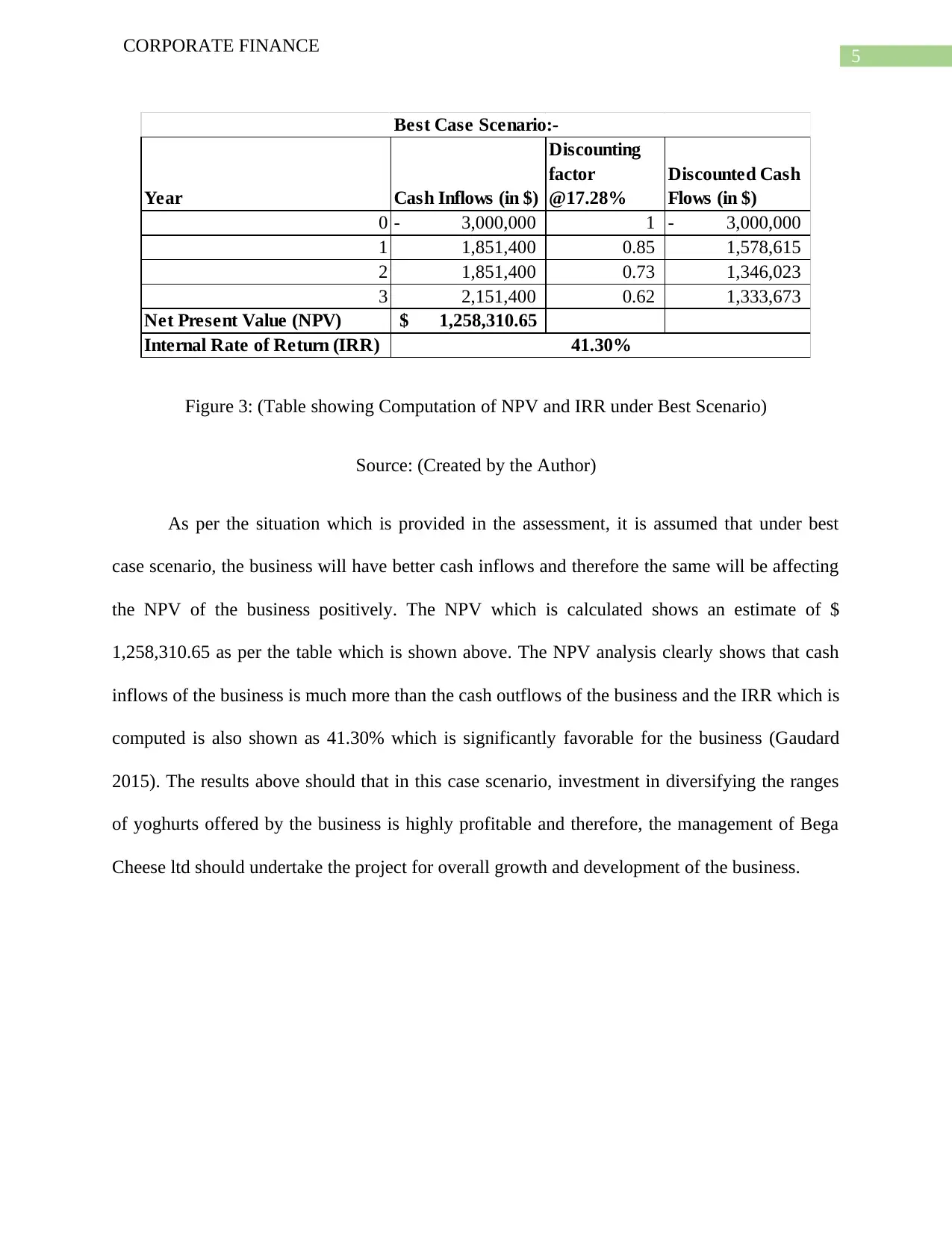
5
CORPORATE FINANCE
Year Cash Inflows (in $)
Discounting
factor
@17.28%
Discounted Cash
Flows (in $)
0 3,000,000- 1 3,000,000-
1 1,851,400 0.85 1,578,615
2 1,851,400 0.73 1,346,023
3 2,151,400 0.62 1,333,673
Net Present Value (NPV) 1,258,310.65$
Internal Rate of Return (IRR)
Best Case Scenario:-
41.30%
Figure 3: (Table showing Computation of NPV and IRR under Best Scenario)
Source: (Created by the Author)
As per the situation which is provided in the assessment, it is assumed that under best
case scenario, the business will have better cash inflows and therefore the same will be affecting
the NPV of the business positively. The NPV which is calculated shows an estimate of $
1,258,310.65 as per the table which is shown above. The NPV analysis clearly shows that cash
inflows of the business is much more than the cash outflows of the business and the IRR which is
computed is also shown as 41.30% which is significantly favorable for the business (Gaudard
2015). The results above should that in this case scenario, investment in diversifying the ranges
of yoghurts offered by the business is highly profitable and therefore, the management of Bega
Cheese ltd should undertake the project for overall growth and development of the business.
CORPORATE FINANCE
Year Cash Inflows (in $)
Discounting
factor
@17.28%
Discounted Cash
Flows (in $)
0 3,000,000- 1 3,000,000-
1 1,851,400 0.85 1,578,615
2 1,851,400 0.73 1,346,023
3 2,151,400 0.62 1,333,673
Net Present Value (NPV) 1,258,310.65$
Internal Rate of Return (IRR)
Best Case Scenario:-
41.30%
Figure 3: (Table showing Computation of NPV and IRR under Best Scenario)
Source: (Created by the Author)
As per the situation which is provided in the assessment, it is assumed that under best
case scenario, the business will have better cash inflows and therefore the same will be affecting
the NPV of the business positively. The NPV which is calculated shows an estimate of $
1,258,310.65 as per the table which is shown above. The NPV analysis clearly shows that cash
inflows of the business is much more than the cash outflows of the business and the IRR which is
computed is also shown as 41.30% which is significantly favorable for the business (Gaudard
2015). The results above should that in this case scenario, investment in diversifying the ranges
of yoghurts offered by the business is highly profitable and therefore, the management of Bega
Cheese ltd should undertake the project for overall growth and development of the business.
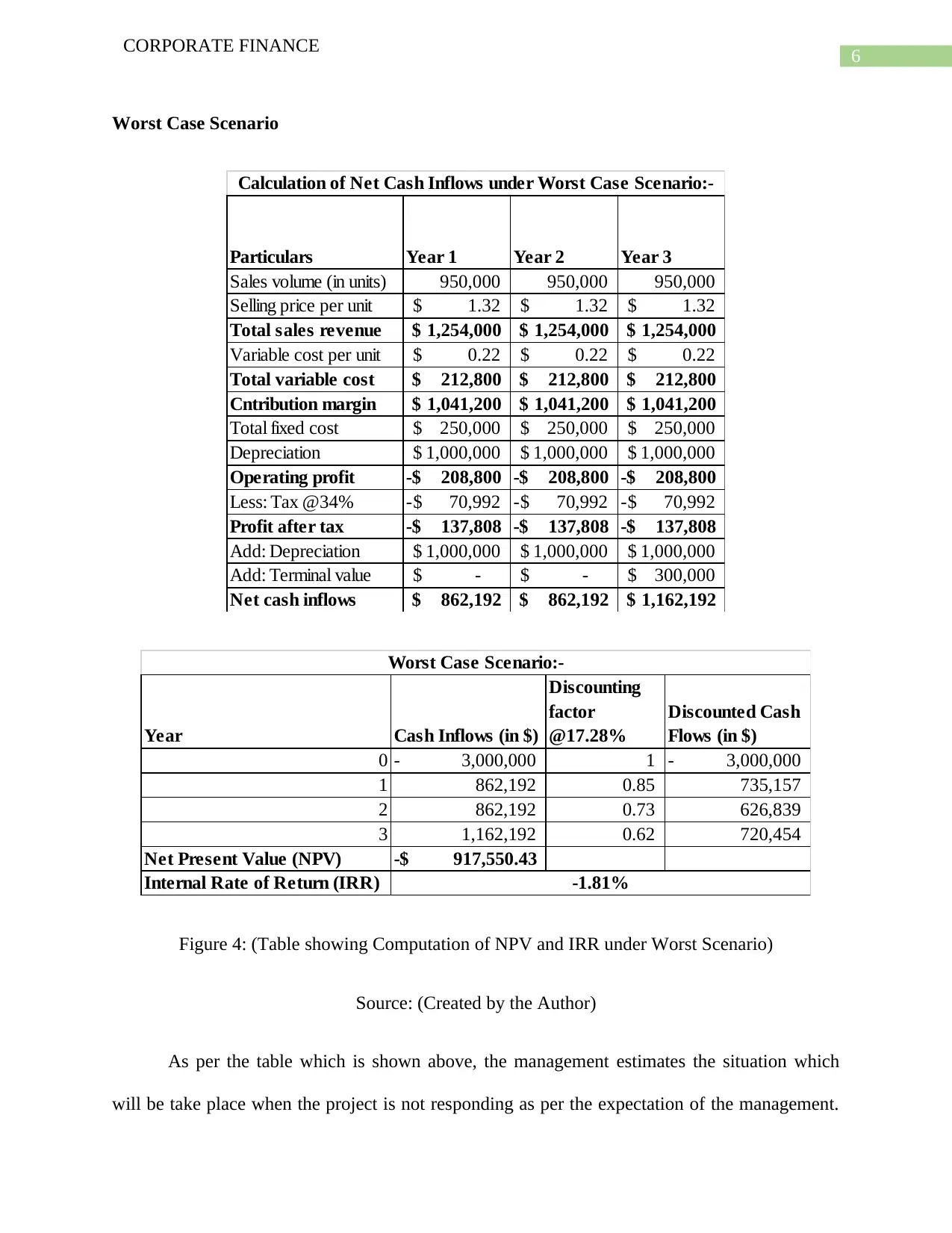
6
CORPORATE FINANCE
Worst Case Scenario
Particulars Year 1 Year 2 Year 3
Sales volume (in units) 950,000 950,000 950,000
Selling price per unit 1.32$ 1.32$ 1.32$
Total sales revenue 1,254,000$ 1,254,000$ 1,254,000$
Variable cost per unit 0.22$ 0.22$ 0.22$
Total variable cost 212,800$ 212,800$ 212,800$
Cntribution margin 1,041,200$ 1,041,200$ 1,041,200$
Total fixed cost 250,000$ 250,000$ 250,000$
Depreciation 1,000,000$ 1,000,000$ 1,000,000$
Operating profit 208,800-$ 208,800-$ 208,800-$
Less: Tax @34% 70,992-$ 70,992-$ 70,992-$
Profit after tax 137,808-$ 137,808-$ 137,808-$
Add: Depreciation 1,000,000$ 1,000,000$ 1,000,000$
Add: Terminal value -$ -$ 300,000$
Net cash inflows 862,192$ 862,192$ 1,162,192$
Calculation of Net Cash Inflows under Worst Case Scenario:-
Year Cash Inflows (in $)
Discounting
factor
@17.28%
Discounted Cash
Flows (in $)
0 3,000,000- 1 3,000,000-
1 862,192 0.85 735,157
2 862,192 0.73 626,839
3 1,162,192 0.62 720,454
Net Present Value (NPV) 917,550.43-$
Internal Rate of Return (IRR)
Worst Case Scenario:-
-1.81%
Figure 4: (Table showing Computation of NPV and IRR under Worst Scenario)
Source: (Created by the Author)
As per the table which is shown above, the management estimates the situation which
will be take place when the project is not responding as per the expectation of the management.
CORPORATE FINANCE
Worst Case Scenario
Particulars Year 1 Year 2 Year 3
Sales volume (in units) 950,000 950,000 950,000
Selling price per unit 1.32$ 1.32$ 1.32$
Total sales revenue 1,254,000$ 1,254,000$ 1,254,000$
Variable cost per unit 0.22$ 0.22$ 0.22$
Total variable cost 212,800$ 212,800$ 212,800$
Cntribution margin 1,041,200$ 1,041,200$ 1,041,200$
Total fixed cost 250,000$ 250,000$ 250,000$
Depreciation 1,000,000$ 1,000,000$ 1,000,000$
Operating profit 208,800-$ 208,800-$ 208,800-$
Less: Tax @34% 70,992-$ 70,992-$ 70,992-$
Profit after tax 137,808-$ 137,808-$ 137,808-$
Add: Depreciation 1,000,000$ 1,000,000$ 1,000,000$
Add: Terminal value -$ -$ 300,000$
Net cash inflows 862,192$ 862,192$ 1,162,192$
Calculation of Net Cash Inflows under Worst Case Scenario:-
Year Cash Inflows (in $)
Discounting
factor
@17.28%
Discounted Cash
Flows (in $)
0 3,000,000- 1 3,000,000-
1 862,192 0.85 735,157
2 862,192 0.73 626,839
3 1,162,192 0.62 720,454
Net Present Value (NPV) 917,550.43-$
Internal Rate of Return (IRR)
Worst Case Scenario:-
-1.81%
Figure 4: (Table showing Computation of NPV and IRR under Worst Scenario)
Source: (Created by the Author)
As per the table which is shown above, the management estimates the situation which
will be take place when the project is not responding as per the expectation of the management.
Paraphrase This Document
Need a fresh take? Get an instant paraphrase of this document with our AI Paraphraser
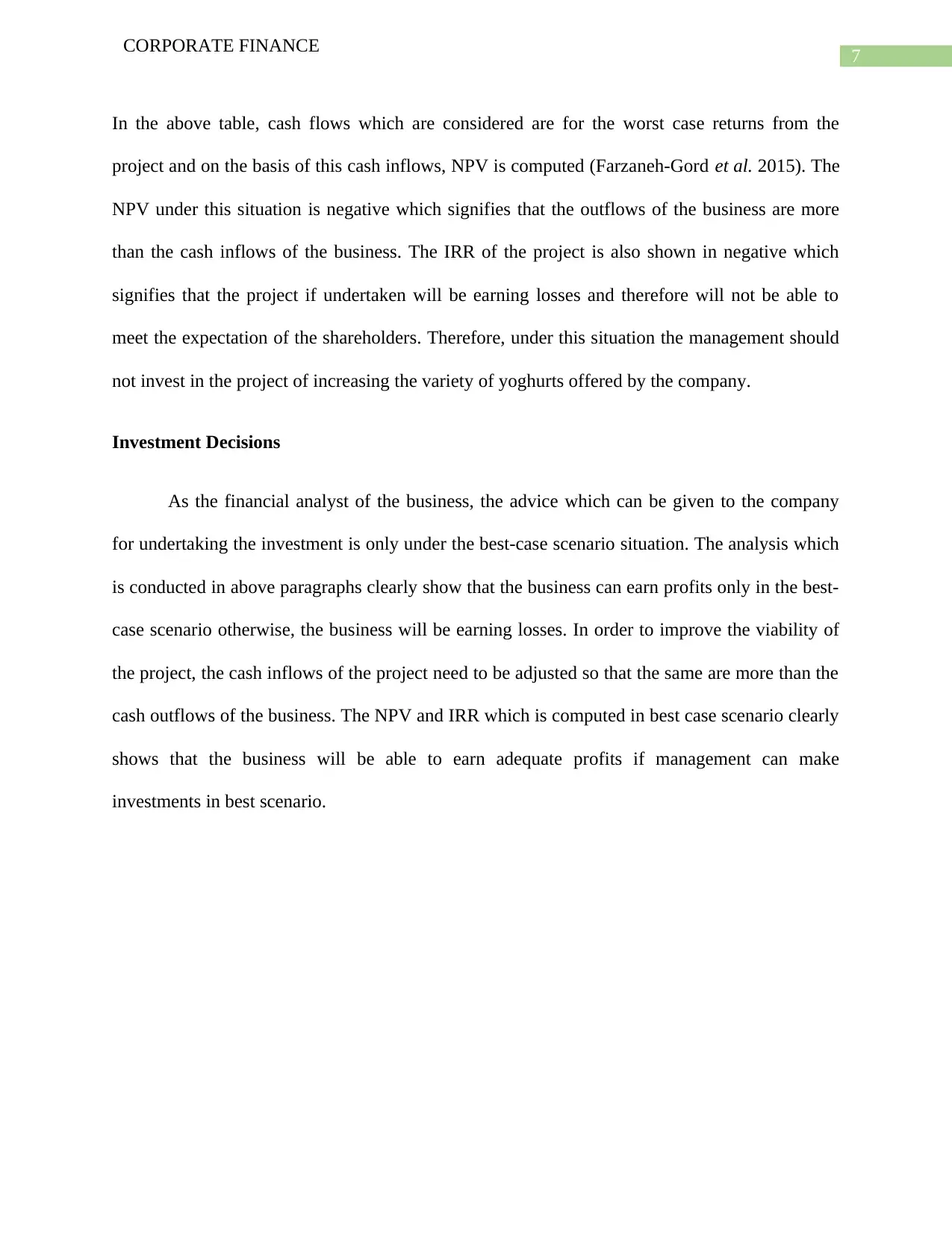
7
CORPORATE FINANCE
In the above table, cash flows which are considered are for the worst case returns from the
project and on the basis of this cash inflows, NPV is computed (Farzaneh-Gord et al. 2015). The
NPV under this situation is negative which signifies that the outflows of the business are more
than the cash inflows of the business. The IRR of the project is also shown in negative which
signifies that the project if undertaken will be earning losses and therefore will not be able to
meet the expectation of the shareholders. Therefore, under this situation the management should
not invest in the project of increasing the variety of yoghurts offered by the company.
Investment Decisions
As the financial analyst of the business, the advice which can be given to the company
for undertaking the investment is only under the best-case scenario situation. The analysis which
is conducted in above paragraphs clearly show that the business can earn profits only in the best-
case scenario otherwise, the business will be earning losses. In order to improve the viability of
the project, the cash inflows of the project need to be adjusted so that the same are more than the
cash outflows of the business. The NPV and IRR which is computed in best case scenario clearly
shows that the business will be able to earn adequate profits if management can make
investments in best scenario.
CORPORATE FINANCE
In the above table, cash flows which are considered are for the worst case returns from the
project and on the basis of this cash inflows, NPV is computed (Farzaneh-Gord et al. 2015). The
NPV under this situation is negative which signifies that the outflows of the business are more
than the cash inflows of the business. The IRR of the project is also shown in negative which
signifies that the project if undertaken will be earning losses and therefore will not be able to
meet the expectation of the shareholders. Therefore, under this situation the management should
not invest in the project of increasing the variety of yoghurts offered by the company.
Investment Decisions
As the financial analyst of the business, the advice which can be given to the company
for undertaking the investment is only under the best-case scenario situation. The analysis which
is conducted in above paragraphs clearly show that the business can earn profits only in the best-
case scenario otherwise, the business will be earning losses. In order to improve the viability of
the project, the cash inflows of the project need to be adjusted so that the same are more than the
cash outflows of the business. The NPV and IRR which is computed in best case scenario clearly
shows that the business will be able to earn adequate profits if management can make
investments in best scenario.
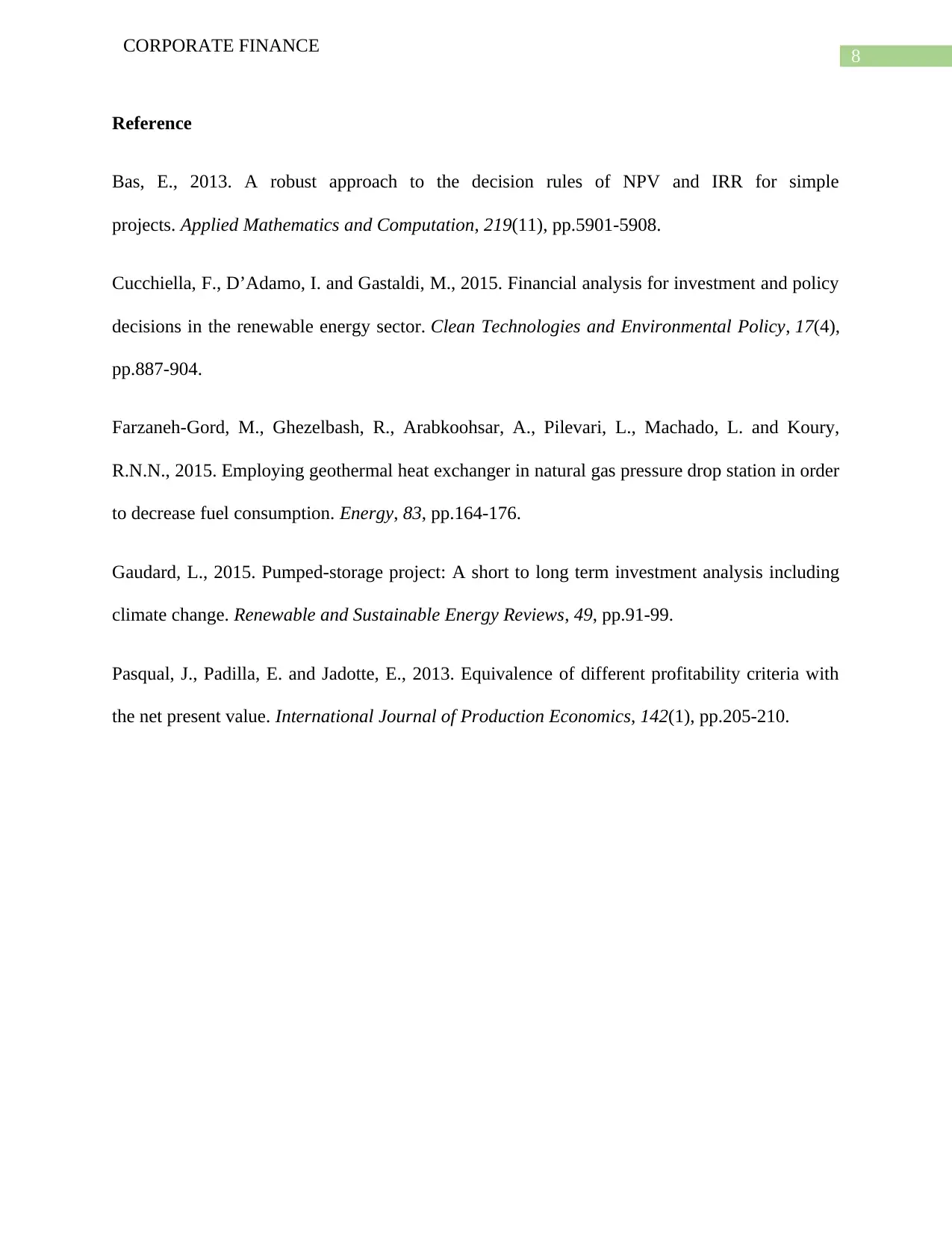
8
CORPORATE FINANCE
Reference
Bas, E., 2013. A robust approach to the decision rules of NPV and IRR for simple
projects. Applied Mathematics and Computation, 219(11), pp.5901-5908.
Cucchiella, F., D’Adamo, I. and Gastaldi, M., 2015. Financial analysis for investment and policy
decisions in the renewable energy sector. Clean Technologies and Environmental Policy, 17(4),
pp.887-904.
Farzaneh-Gord, M., Ghezelbash, R., Arabkoohsar, A., Pilevari, L., Machado, L. and Koury,
R.N.N., 2015. Employing geothermal heat exchanger in natural gas pressure drop station in order
to decrease fuel consumption. Energy, 83, pp.164-176.
Gaudard, L., 2015. Pumped-storage project: A short to long term investment analysis including
climate change. Renewable and Sustainable Energy Reviews, 49, pp.91-99.
Pasqual, J., Padilla, E. and Jadotte, E., 2013. Equivalence of different profitability criteria with
the net present value. International Journal of Production Economics, 142(1), pp.205-210.
CORPORATE FINANCE
Reference
Bas, E., 2013. A robust approach to the decision rules of NPV and IRR for simple
projects. Applied Mathematics and Computation, 219(11), pp.5901-5908.
Cucchiella, F., D’Adamo, I. and Gastaldi, M., 2015. Financial analysis for investment and policy
decisions in the renewable energy sector. Clean Technologies and Environmental Policy, 17(4),
pp.887-904.
Farzaneh-Gord, M., Ghezelbash, R., Arabkoohsar, A., Pilevari, L., Machado, L. and Koury,
R.N.N., 2015. Employing geothermal heat exchanger in natural gas pressure drop station in order
to decrease fuel consumption. Energy, 83, pp.164-176.
Gaudard, L., 2015. Pumped-storage project: A short to long term investment analysis including
climate change. Renewable and Sustainable Energy Reviews, 49, pp.91-99.
Pasqual, J., Padilla, E. and Jadotte, E., 2013. Equivalence of different profitability criteria with
the net present value. International Journal of Production Economics, 142(1), pp.205-210.
1 out of 9
Related Documents
Your All-in-One AI-Powered Toolkit for Academic Success.
+13062052269
info@desklib.com
Available 24*7 on WhatsApp / Email
![[object Object]](/_next/static/media/star-bottom.7253800d.svg)
Unlock your academic potential
© 2024 | Zucol Services PVT LTD | All rights reserved.




